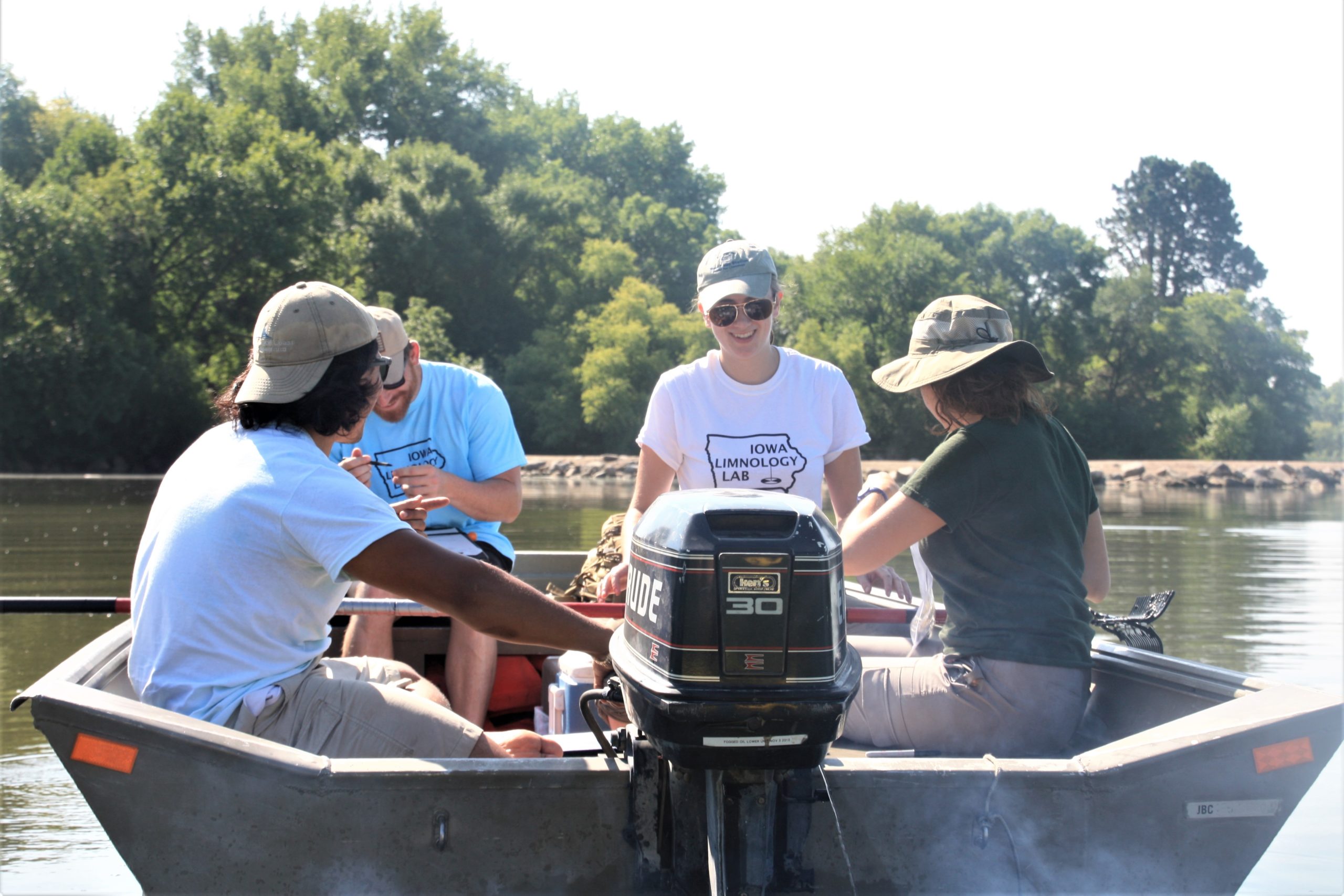We ask Marshall McDaniel, Assistant Professor in Agronomy at Iowa State University, the question: What does healthy soil look like?
Continue readingResearchers Looking into the Effects of Pharmaceuticals on Fish in Iowa’s Waterways
Written by Sarah Feehan
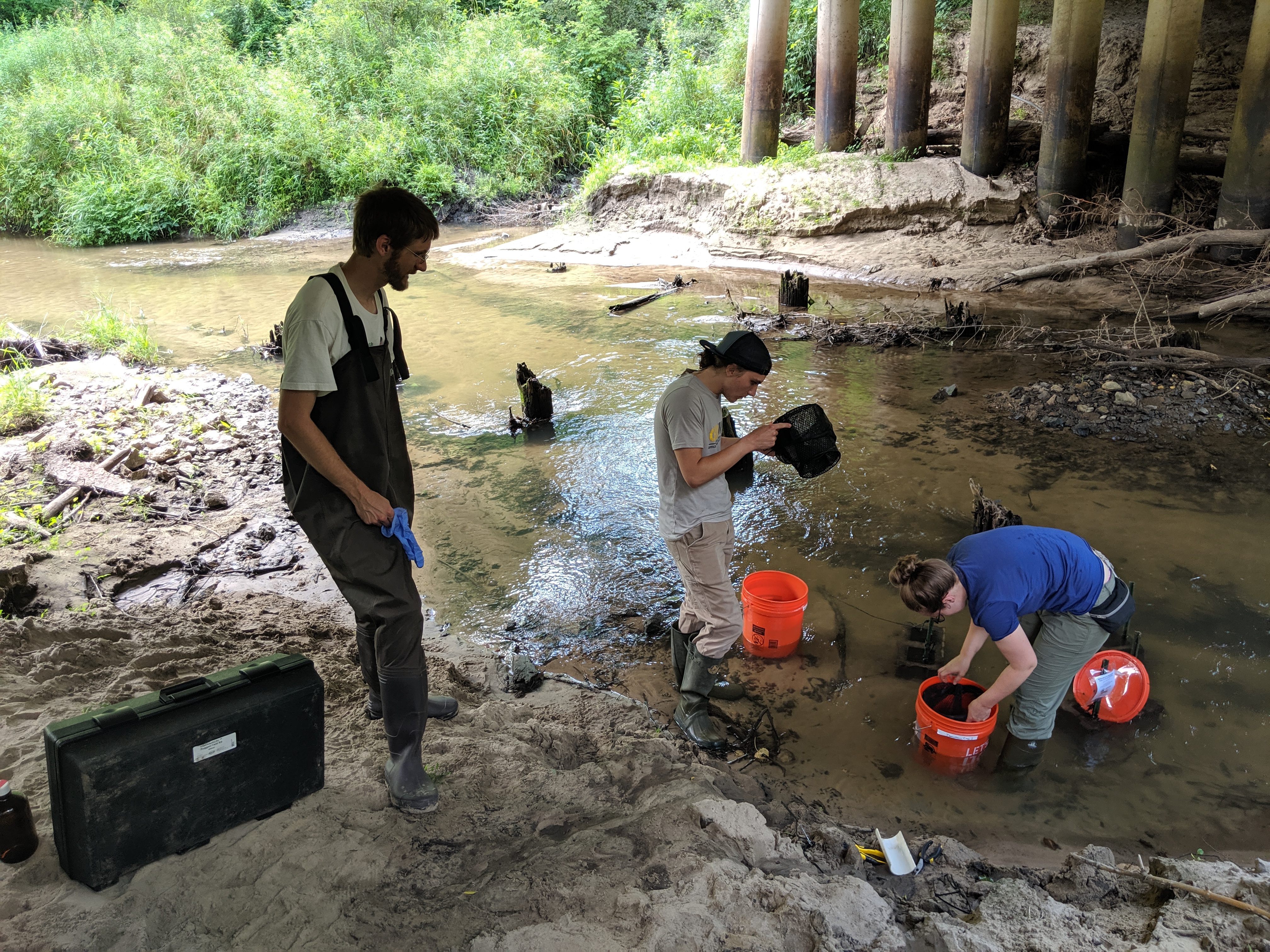
Lab-reared, native minnows have been living in fish cages placed in a stream for the last four days, and now a team of researchers collects them to study the impacts of water quality on aquatic organisms.
For nearly the past two years, these researchers have been measuring chemical concentrations in the same stream, and this caged fish experiment is one of the ways researchers are connecting chemical presence in the environment to possible biological effects.
Greg LeFevre, an assistant professor of environmental engineering and faculty research engineer for IIHR at the University of Iowa, studies water quality, wastewater, and toxic substances.
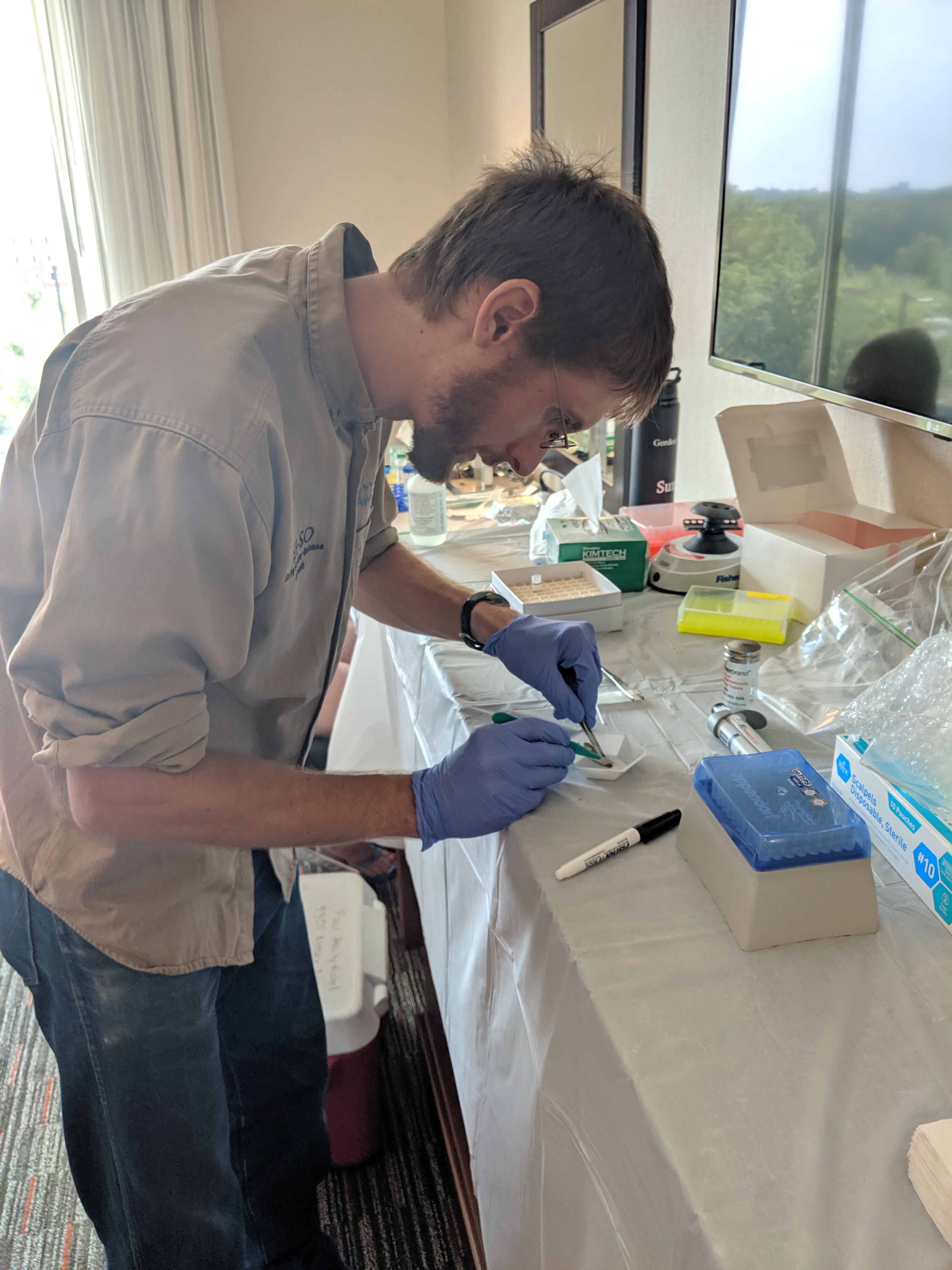
LeFevre, a principal investigator (PI) of the study, is researching what happens when pharmaceuticals enter our waterways. His research is funded through a National Competitive Grant under the USGS 104(g) Program. A goal of this program is to promote collaboration between the USGS and university scientists in research on significant national and regional water resources issues.
This working group consisted of representatives from the University of Iowa, the University of Wisconsin at Milwaukee, and the United States Geological Survey (USGS). There were PIs, graduate students, and USGS scientists.
“We have a number of different things we are working on both in the lab and in the field to try and answer the questions comprehensively through multiple fields of expertise,” LeFevre says. “And out of this one grant, because there are so many things coming out of this, we hope that this field site will be the locus for a bunch of other research.”
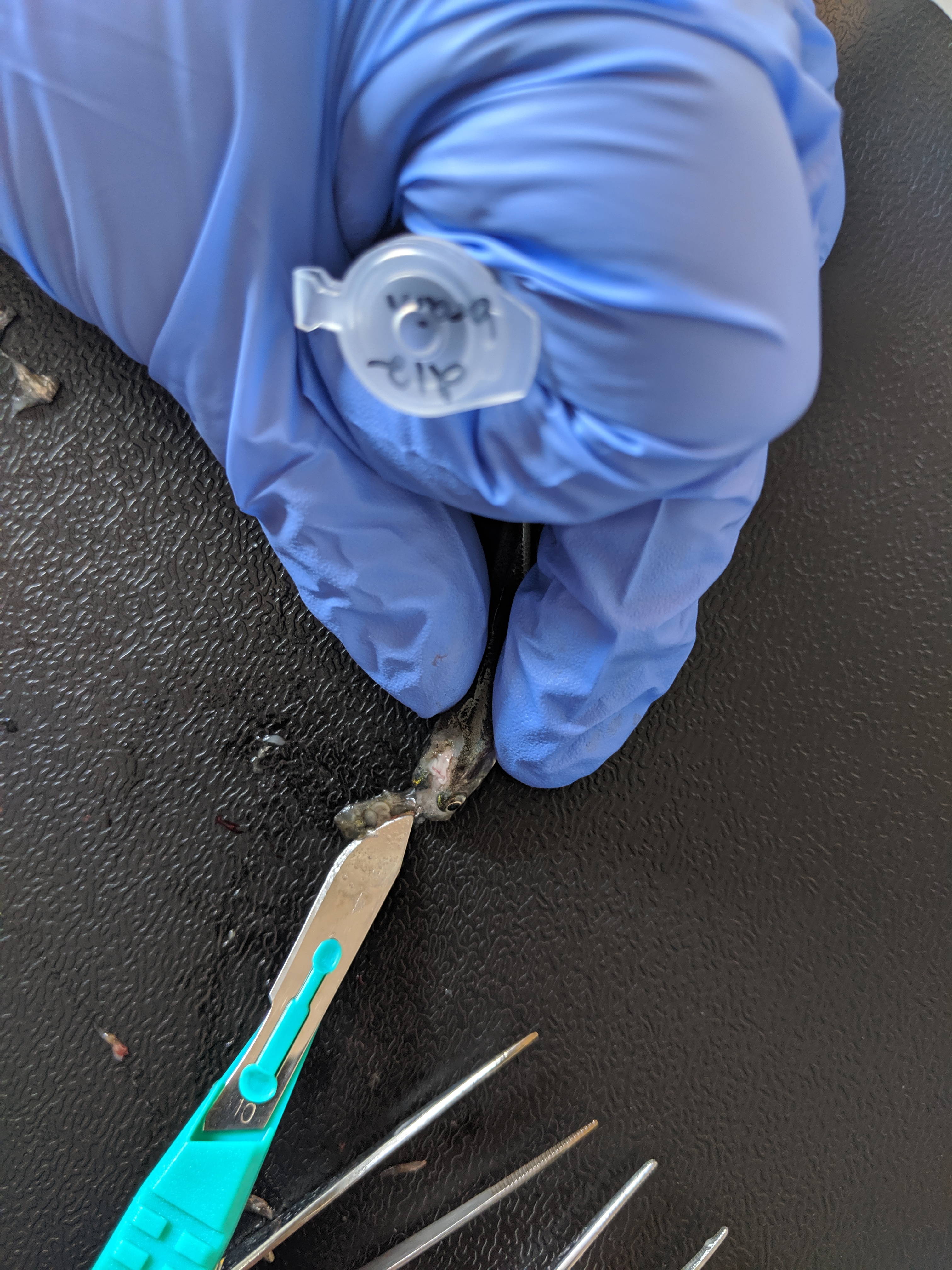
Wastewater-derived contaminants of emerging concerns (CEC) have demonstrated harmful effects to aquatic organisms. LeFevre believes that there is a critical need to understand how the changing complex mixture composition of CECs relates to biological effects. This understanding is critical in order to better protect ecosystem health in freshwater resources and inform stakeholder decisions.
“Everything that happens on the land is ultimately very connected to what goes on and into the water,” says LeFevre. “What we want to do is to develop some kind of understanding of the exposure to fish as well as some of the biological facts that are going on there.”
They hope to see the effects on fish throughout different areas of the stream. They will study a control group that permanently remains at the lab, a different group released in cages in the waterway after being brought up in the lab, and native fish who have spent their whole lives in the natural stream.
The waterway they are putting fish in and pulling fish from comes from an upstream wastewater treatment facility LeFevre describes as, “one of the best in the state.”
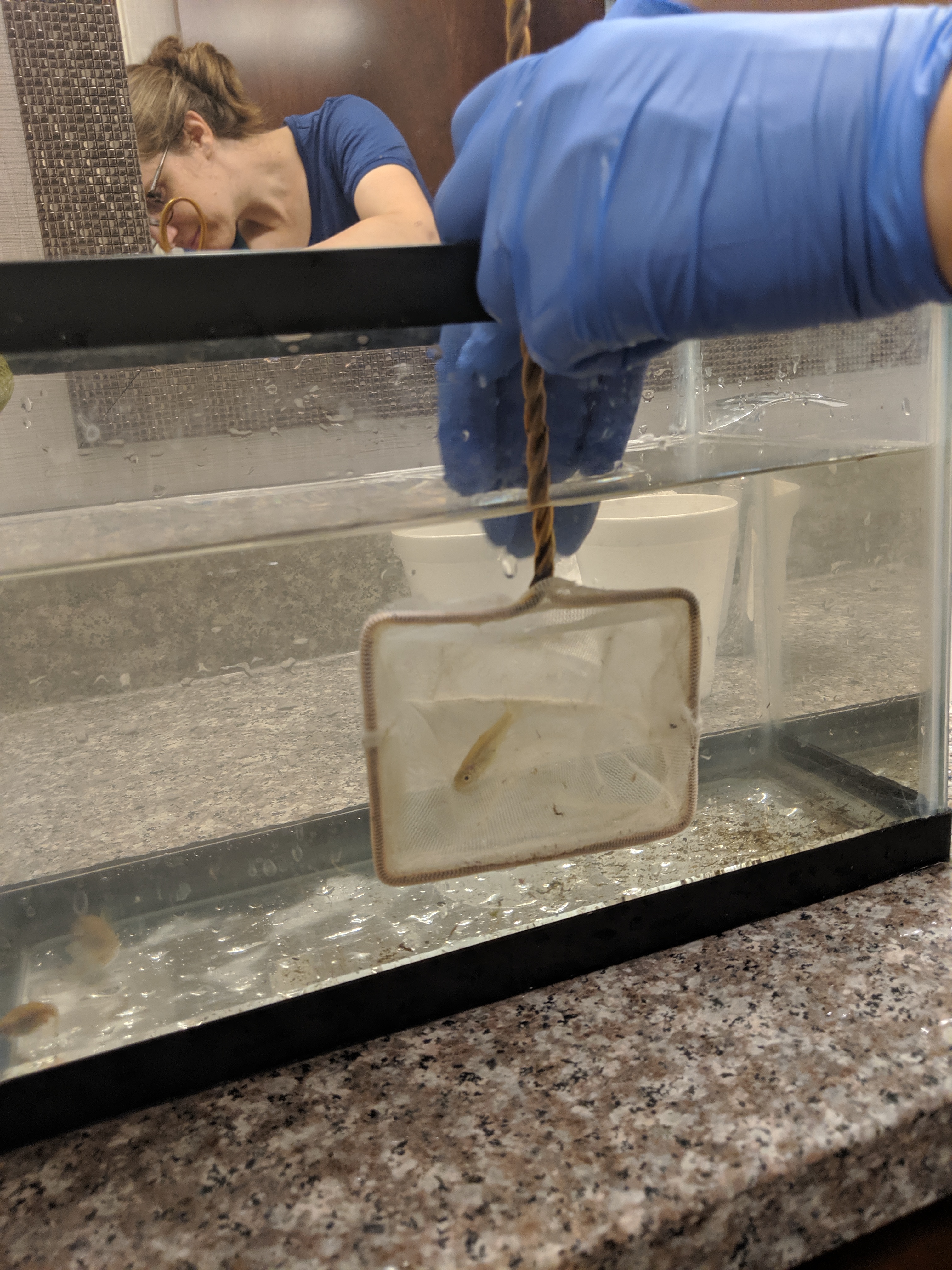
The North Liberty Wastewater Treatment Plant, upstream of the tested waterway, has a membrane bioreactor, zero E. coli that comes out of the plant, and biological phosphorus and nitrogen removal. All of which is far beyond the permit requirements.
Rebecca Klaper, professor at the School of Freshwater Sciences at the University of Wisconsin at Milwaukee, is a co-principal investigator on the study has also been a key collaborator to LeFevre’s research.
Regarding the data, Klaper explains, “The detection part is fantastic and the fact that we’ve gotten so much better at measuring these things is great. We might detect hundreds of chemicals in the water, but they might have no effect at all. So, the other part is trying to figure out if we really need to be concerned about them.”
“Today has been really exciting,” PhD candidate and research assistant at the University of Iowa Hui Zhi says. Zhi is one of four Iowa Water Center (IWC) Graduate Student Research Competition recipients for 2019.
“I think we were overprepared, which is great,” she says. “Having everything ready to go makes our work more efficient. And we also have so many people from our labs working together, making everything work very smoothly.”
Part of Zhi’s research through the IWC grant encompasses the sorption and biodegradation of pharmaceuticals in Iowa’s water. “It’s important we understand what’s in our drinking water, what’s in the treated wastewater, and what’s in the streams and rivers,” Zhi says.

Sarah Feehan is the communications specialist for the Iowa Water Center. She holds a BS in Journalism and Mass Communication with a minor in Political Science from Iowa State University. In fall of 2019, Feehan will begin acquiring her JD from Drake Law School.
Bates Awarded SWCS Commendation
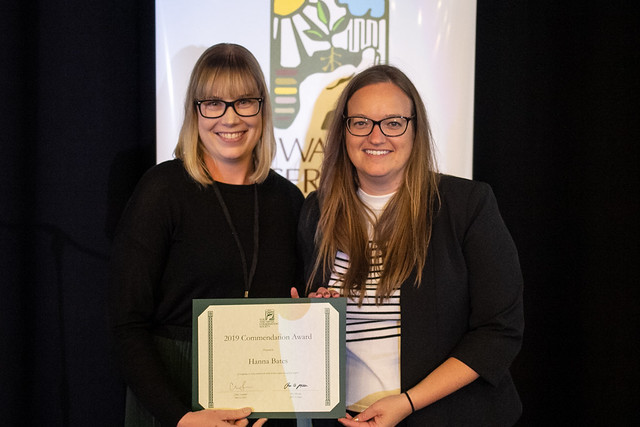
During the 74th Soil and Water Conservation Society International Annual Conference in July, Program Coordinator Hanna Bates was awarded a Commendation Award for work contributed to the Iowa Chapter.
As stated in the Conference program:
Hanna Bates is an essential leader in the Iowa Chapter. She recognized a widespread, national demand on food banks and soup kitchens during the federal government shutdown. Using her exceptional leadership skills to address this need, Bates spearheaded an effort by the Iowa Chapter to provide social events in each of the Chapter’s five regions during the spring of 2019 to help respond to local food pantry needs. Bates’s efforts resulted in the gathering of at least 40 people at the first three events, and over 300 pounds of food donated to local food pantries. Ultimately, this initiative resulted in the registration of at least four new Iowa SWCS individual members and forged relationships between the Chapter and five other conservation-oriented organizations, as well as five food pantries across the state. Bates is serving her first term as a chapter officer, acting as the president elect. She also serves in a Society level capacity on the Conference Planning Committee, where she assists in reviewing presentation submissions. For these and other reasons, Hanna Bates is most deserving of the 2019 SWCS Commendation Award.
Ask a Scientist – Resilience
We ask Craig Just, Associate Professor in Civil and Environmental Engineering at the University of Iowa, the question: What is resiliency?
Continue reading#IWConf20 Call for Presentation Proposals
Deadline: September 30, 2019 11:59PM
Iowa Water Conference 20/20: Bringing Our Water Vision into Focus
Scheman Building, Ames, Iowa
April 8-9, 2020
What does the path to meaningful change look like across the vast spectrum of water resource issues? Who are the drivers of change and who should be included at the table as critical change agents? The theme of the 2020 Iowa Water Conference is centered on answering these questions. We want to transform water resource work in the year 2020 to be 20/20 as an effort to refocus our vision of the future for how we can promote inclusive, resilient water resource management.
This conference will focus on our evolving relationship with water at a personal and societal scale, as well as what the future may hold if we continue our current trajectory. Through scientific discovery, diverse change agents, and foresight on future challenges, we will move into an equitable and verdurous world of the future.
The committee welcomes proposals on all water-related topics, but especially encourage submissions that address:
- Equity, inclusion, and environmental justice
- Innovations in agriculture for future resilience
- Emerging water resource contaminants
- Meeting future Gulf of Mexico Hypoxia targets
- Social impacts on conservation
- Mitigating climate change impacts on water resources
- Nontraditional approaches to citizen engagement with water
Read more here.
Ask a Scientist – Geographic Information Systems
[youtube https://www.youtube.com/watch?v=se_lbnjsuXA]
Ask a Scientist – Flood Modeling
[youtube https://www.youtube.com/watch?v=GY6a9qEkrso]
Iowa Water Center Visit Up North
Post written by Melissa Miller, Associate Director for the Iowa Water Center
![IMG_E6094[1]](https://www.iowawatercenter.org/wp-content/uploads/2019/07/img_e60941.jpg)
One of the greatest benefits of being part of the National Institutes for Water Resources is the connection to the other 53 Water Resources Research Institutes across the country – including those in surrounding states. Last week, Iowa Water Center staff took a day trip up to the St. Paul campus of the University of Minnesota to visit the Minnesota Water Resources Center (MWRC) staff.
We had a full agenda for the day, well-planned by Iowa State University alum Adam Wilke, who serves as the MWRC Research and Outreach Coordinator.
After a quick tour of the campus with our colleagues MWRC Director Jeff Peterson and Associate Director Joel Larson, we visited with MWRC’s Ann Lewandowski and Matt Drewitz from the Minnesota Board of Soil and Water Resources on the best outreach and communication methods for the Daily Erosion Project (coverage for the entire state of Minnesota coming very soon!).
Next, Leif Olmanson from UMN’s Remote Sensing and Geospatial Analysis Laboratory and Ben Page from MWRC introduced us to remotely sensed water quality monitoring in Minnesota lakes with their tool, LakeBrowser. This technology is helping Minnesotans keep an eye on water clarity, chlorophyll, suspended solids, and colored dissolved organic matter on all lakes in the state over 10 acres. LakeBrowser covers some lakes in Iowa and can be expanded outside the borders of Minnesota.
We enjoyed lunch with the entire MWRC crew. Afterward, we joined in a planning call for the University Council of Water Resources annual conference, to be held in Minneapolis June 9-11. The theme for the 2020 UCOWR Annual Conference is “Water. Place. People.” The call for special sessions is now open – this is a great conference for university researchers and students, and we encourage you to submit a session idea.
![IMG_6100[1]](https://www.iowawatercenter.org/wp-content/uploads/2019/07/img_61001.jpg) To round out the day, we headed over to the banks of the Mississippi River to chat with Pat Nunnally from UMN’s River Life program. We talked about the history of the Mississippi and River Life’s interdisciplinary journal Open Rivers, which features fascinating pieces that explore topics on water, place, and community. We also got to witness Pat in action, as a mudslide on the banks that morning brought television news crews to the scene, wondering how and why these things occur (Pat makes an appearance around 1:35). Thankfully, we managed to avoid any cameos in the news story!
To round out the day, we headed over to the banks of the Mississippi River to chat with Pat Nunnally from UMN’s River Life program. We talked about the history of the Mississippi and River Life’s interdisciplinary journal Open Rivers, which features fascinating pieces that explore topics on water, place, and community. We also got to witness Pat in action, as a mudslide on the banks that morning brought television news crews to the scene, wondering how and why these things occur (Pat makes an appearance around 1:35). Thankfully, we managed to avoid any cameos in the news story!
![IMG_6098[1]](https://www.iowawatercenter.org/wp-content/uploads/2019/07/img_60981-1.jpg) We want to sincerely thank the entire UMN staff for their hospitality. We came away with actionable items to increase our collaboration between the two centers and throughout the region, as well as some great ideas we might borrow from UMN to incorporate here in Iowa and at IWC. We look forward to their visit to Iowa next spring!
We want to sincerely thank the entire UMN staff for their hospitality. We came away with actionable items to increase our collaboration between the two centers and throughout the region, as well as some great ideas we might borrow from UMN to incorporate here in Iowa and at IWC. We look forward to their visit to Iowa next spring!
 Melissa Miller is the associate director of the Iowa Water Center. She holds a BS in Kinesiology with an emphasis in Community and Public Health and MS degree in Community Development with an emphasis in Natural Resource Management, both from Iowa State University.
Melissa Miller is the associate director of the Iowa Water Center. She holds a BS in Kinesiology with an emphasis in Community and Public Health and MS degree in Community Development with an emphasis in Natural Resource Management, both from Iowa State University.
Ask a Scientist – Daily Erosion Project
[youtube https://www.youtube.com/watch?v=o9FJGgBGmf0]
Albright Selected as a Recipient for the Iowa Water Center’s Institute Research Grant Competition
Written by Sarah Feehan, Communications Specialist, Iowa Water Center
AMES, IOWA – The Iowa Water Center (IWC) annually administers a statewide grant competition known as the IWC Graduate Student Research Competition.
The purpose of this funding is to enable graduate students to complete additional research objectives beyond the scope of their current work, with an emphasis on submitting their research to peer-reviewed publications.
Ellen Albright has been selected among three other graduate students from across Iowa. She and the other recipients will receive funding for a variety of proposed research.
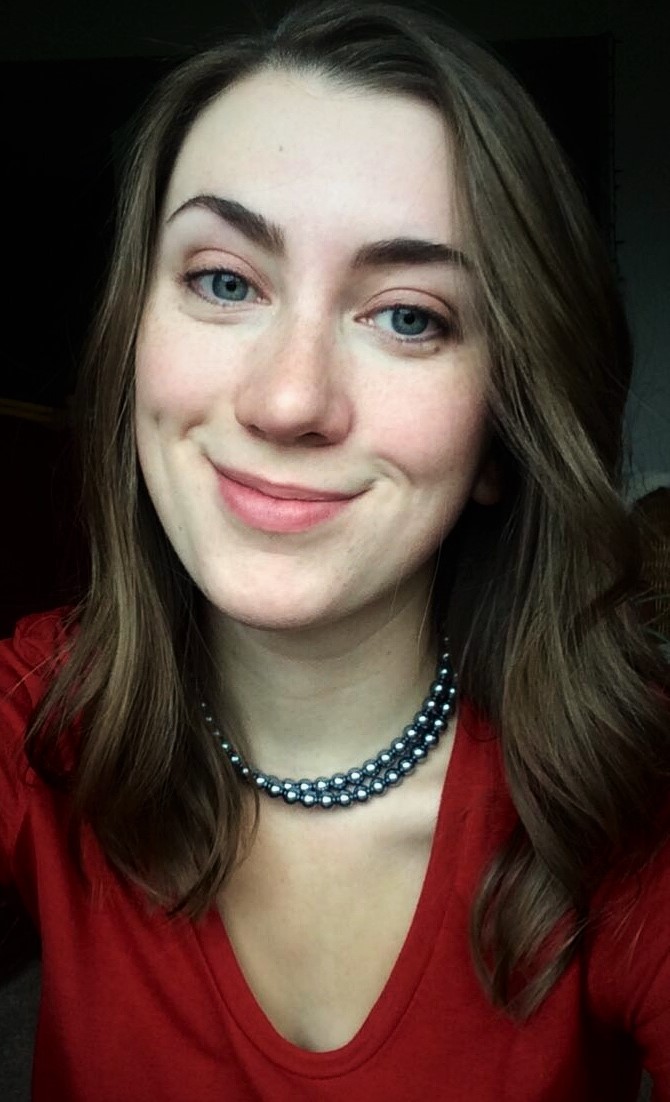
Albright’s proposed research focuses on internal phosphorus loading in shallow lakes, as well as management strategies to prevent and help mitigate harmful algal blooms. It is titled ‘Developing Methods to Measure Internal Phosphorus Loading in Iowa Lakes’.
“I’m interested in internal phosphorus loading, which is the release of phosphorus from lakebed sediments into the overlying water,” Albright says. Phosphorus is a limiting nutrient that can cause harmful algal blooms in lakes. Phosphorus stored at the bottom of lakes in sediment can be re-released into the water due to wind disturbance or fish stirring up the sediment.
Associate Director of the IWC Melissa Miller says, “Water Resources Research Institutes like the Iowa Water Center were authorized by Congress in part to address emerging water resources concerns through research. Harmful algal blooms are a high-priority topic in the nation. Ms. Albright’s work will not only contribute to the body of knowledge on internal phosphorus loading, but will also contribute a new, scalable sampling method,” Miller says.
Albright says, “Internal phosphorus loading can maintain high nutrient levels in our lakes. And it’s not very well understood in the shallow lakes we have here in Iowa. It can also impact how effective watershed nutrient reduction strategies are at achieving water quality goals.”
Get to know Ellen Albright, PhD Student at Iowa State University
Albright grew up in a small town just outside of Madison, Wisconsin, called Cottage Grove. Her main area of research is limnology, or the study of inland waters such as lakes, rivers, and wetlands.
“My interest in limnology started during a summer undergrad position that I had with the University of Wisconsin-Madison. I worked at a field station they run in northern Wisconsin called Trout Lake Station,” Albright says.
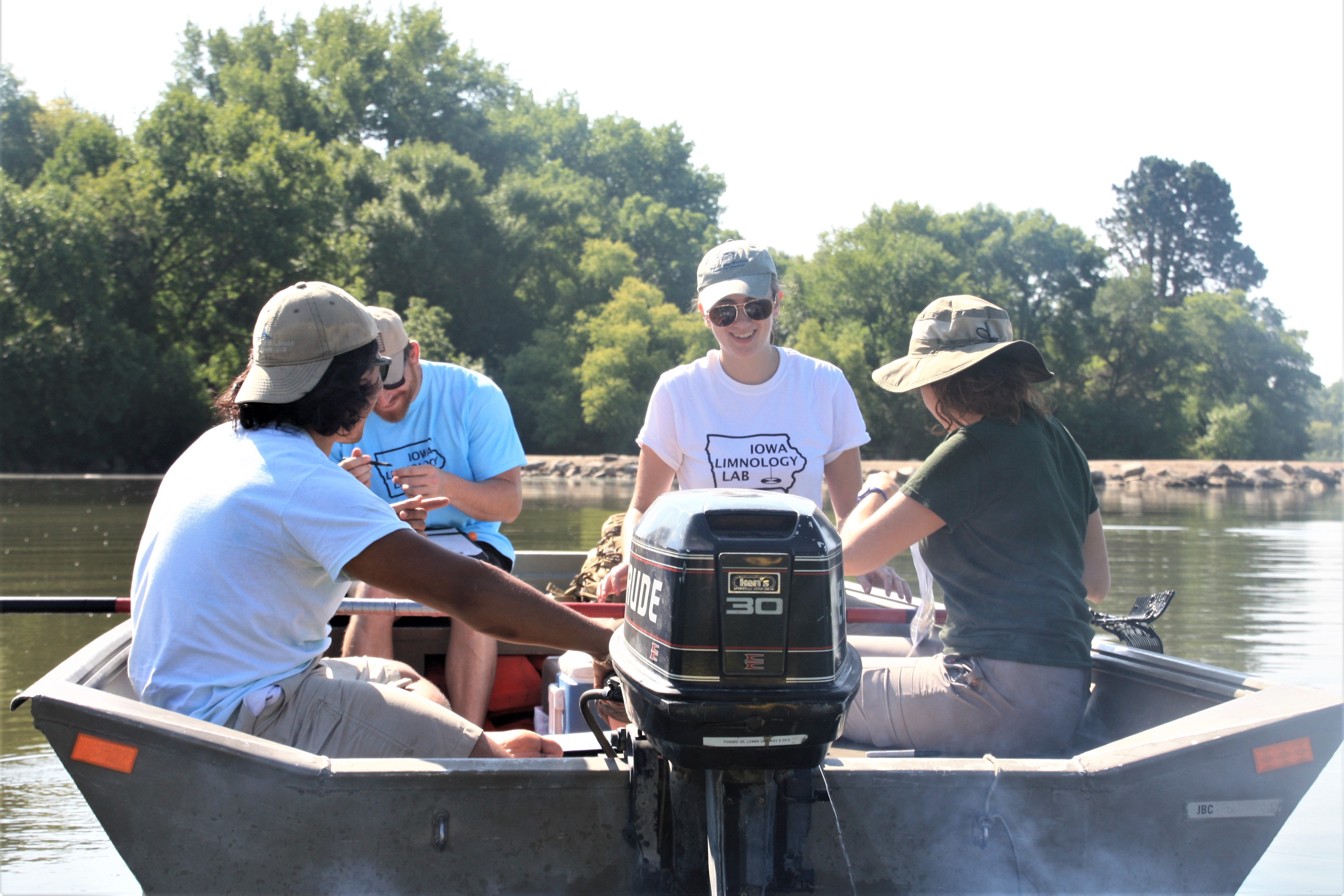
She had a variety of positions there every summer of her undergraduate career. And while she was working there, she learned that she really enjoys research time and enjoys studying lakes.
“While I was there, I got excited about the process of collecting ecological data and knowing that data can help us make decisions and better manage freshwater resources. I think those are the experiences that really sparked the interests I have now,” Albright says.
Throughout and in between the field work days and lab work days, Albright is constantly working with other students, especially in the summertime.
Albright says, “I enjoy training our undergrad researchers for the different roles we have in our lab and encouraging them to pursue independent research projects. I find that mentoring is a really rewarding part of my job.”
In her free time, Albright enjoys getting outdoors. “It’s very relaxing for me. I like to go for walks, go birding, fishing, and get out on the water,” Albright says.
For more information about this year’s recipients, please visit https://iawatercenter.wordpress.com/. To reference the general press release for all four recipients, please visit: http://www.water.iastate.edu/news/iowa-water-center-announces-2019-grant-recipients.
The Iowa Water Center is a federally funded organization, part of the National Institutes for Water Resources. Located on the Iowa State University campus, it is one of 54 institutes located throughout the United States and U.S territories. The purpose of the Iowa Water Center is to identify water-related research needs, provide outreach and education opportunities, and disseminate information about Iowa’s water resources to the public to form better policies and everyday practices. Learn more at https://www.water.iastate.edu/.
 Sarah Feehan is the communications specialist for the Iowa Water Center. She holds a BS in Journalism and Mass Communication with a minor in Political Science from Iowa State University. In fall of 2019, Feehan will begin acquiring her JD from Drake Law School.
Sarah Feehan is the communications specialist for the Iowa Water Center. She holds a BS in Journalism and Mass Communication with a minor in Political Science from Iowa State University. In fall of 2019, Feehan will begin acquiring her JD from Drake Law School.
